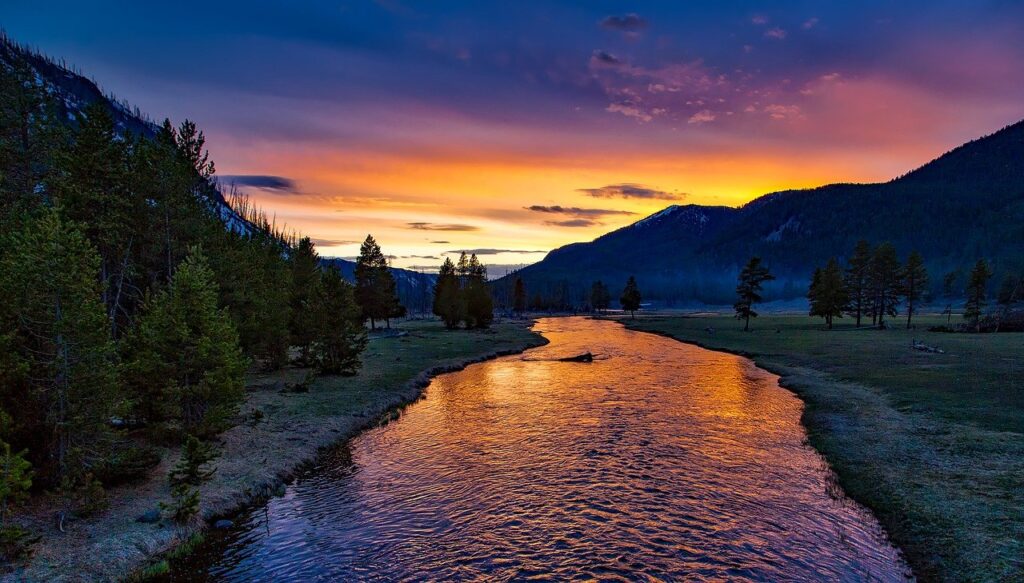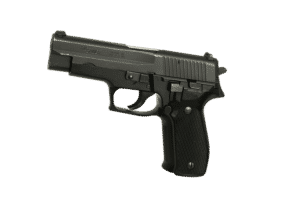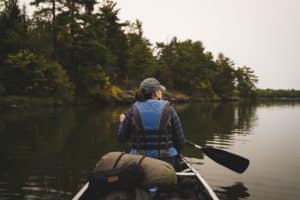
When it comes to fly fishing, there are few things better than spending a day in a stunning national park. From the east coast to the west, America is home to some truly amazing places for getting your cast out. Here are seven of our favorite national parks for fly fishing.
Yellowstone National Park

America’s oldest national park is also one of the best parks for fly fishing.
For many anglers, Yellowstone National Park is the ultimate destination. The park is home to a wide variety of fish, including some of the biggest trout in the world. And with more than 2,000 miles of waterways, Yellowstone offers something for everyone—from beginner anglers to experienced fly-fishers. Here are a few of the best areas to cast your line in Yellowstone:
The Madison River is one of the most popular fishing spots in Yellowstone. The river is home to cutthroat and rainbow trout, as well as brown trout. Anglers can find good success using nymphs and streamers.
Another great option is Yellowstone Lake. This vast lake is teeming with brook trout, cutthroat trout, and lake trout. For the best results, try trolling with flies or lures.
The Yellowstone River is another top choice for Yellowstone anglers. The river is home to brown trout, cutthroat trout, and rainbow trout. Nymphs and streamers are typically the best options here.
Finally, don’t forget about the smaller streams in Yellowstone. These waters are often overlooked, but they can be great places to catch brook trout and
When it comes to fly fishing in Yellowstone National Park, there is no better time than late summer and early fall. During this period, the water levels tend to be at their lowest, making it easier for fishermen to cast their lines and get a bite from a wide variety of fish species. The weather tends to be warm and sunny during this time of year, with perfect conditions for an afternoon on the water. And because the crowds are smaller during this season, it is easy to find well-hidden spots along the riverbanks where you can relax and enjoy the scenery in peace.
The fishing season in Yellowstone begins the Saturday of Memorial Day weekend and extends through the first Sunday in November. Hours are sunrise to sunset. All fishers 16 and older will also need a license. The cost for the license is $40 (3-day permit); $55 (7-day permit); and $75 (season-long permit). You can buy them from a vendor or online at recreation.gov.
Great Smoky Mountains National Park

The Great Smoky Mountains National Park is one of the best places in the country for fly fishing. The park is home to over 2,000 miles of streams and rivers, including several great trout-fishing spots. Some of the best rivers for fly fishing include the Little River, the Oconaluftee River, and the Tuckasegee River. The park also has a number of great lakes, such as Fontana Lake and Cherokee Lake, which are both great for fly fishing. So whether you’re a beginner or an experienced angler, you’re sure to find great fly-fishing opportunities in the Great Smoky Mountains National Park.
Depending on the season, this beautiful park offers a variety of great fishing opportunities. In summer, the best time for fly fishing is early in the morning or late in the evening, when the air is cool, and the fish are feeding actively. During these times of day, you can also expect clear weather and great visibility, making it easy to spot fish under the surface of the water. If you’re looking for cooler temperatures and calmer runs, autumn may be your ideal season for fly fishing in Great Smoky Mountains National Park. This is generally considered to be peak season for anglers, as trout spawn during this time of year and tend to congregate in certain areas along the riverbeds. Whatever time or season you choose to visit great smoky mountains national park, a day spent fly fishing there is sure to be an amazing experience!
Fishing is permitted year-round, from 30 minutes before sunrise to 30 minutes after sunset. You can fish in all the park’s streams.
Since the park lies in both Tennessee and North Carolina, you’ll need a different license, depending on which state you’re in. Licenses for both states can be purchased online and include short-term and annuals licenses. You can get a North Carolina license here. You can get a Tennessee fishing license here.
Olympic National Park

The best time of year for fly fishing in Olympic National Park is from late June to early October. This is when the fish are most active and the weather is typically mild, with little rainfall. The most popular spots for fly fishing in the park are bridge over the Elwha River, beaver ponds near Ozette Lake, and the lakeshore on Sol Duc River. There are also several guided fly fishing tours available, which can be a great way to learn about the best techniques and spots for catching fish. Whether you’re a seasoned fisherman or just getting started, Olympic National Park is a great place to enjoy fly fishing.
If you’re looking for the best areas of Olympic National Park for fly fishing, you’ll want to head to the rivers and streams that flow through the park. The Elwah River is a great option, and is home to steelhead, cutthroat trout, and coho salmon. Another good choice is the Quinault River, which is known for its excellent cutthroat trout fishing. For those wanting to try their hand at fly fishing in Olympic National Park, these two rivers are worth a visit.
The park waters are open to fishing from one hour before sunrise to one hour after sunset. As far as licensing is required, it depends on where you’re fishing. According to the National Park Service:
- A Washington State Recreational Fishing License is NOT REQUIRED to fish in Olympic National Park EXCEPT when fishing in the Pacific Ocean from shore, although children under 15 years of age do not require a license. No license is required to harvest surf smelt.
- A free Washington State catch record card is REQUIRED for adults and children if fishing for salmon or steelhead. A catch record card specific to waters in Olympic National Park is available from Washington State Department of Fish & Wildlife license dealers at no cost. Salmon or steelhead that are caught and released do not need to be recorded. The catch record card requires a location code for each retained fish.
- A Washington State Shellfish/Seaweed license is REQUIRED for harvest of shellfish from the Pacific Coastal Area. Harvest of seaweed, kelp, and unclassified species is prohibited.
Everglades National Park

Everglades National Park is one of the best places in the world for fly fishing. The sprawling marshland offers a wide variety of different fish species, including snook and tarpon, which are known for their large size and fierce fighting abilities. Additionally, the everglades boasts a near-perfect climate for year-round fly fishing, with warm, sunny days and cool evenings that offer ideal conditions for chasing fish in the water. Whether you want to spend an afternoon casting your line in quiet backwaters or head out on an adrenaline-fueled fishing expedition along the winding channels, Everglades National Park has something to offer every fly fisher enthusiast. So if you’re looking for the ultimate angling adventure, look no further than this magical corner of Florida!
If you’re fly fishing in Everglades National Park, you can expect to catch a variety of different fish. Some of the most common species include largemouth bass, tarpon, snook, and redfish. You might also come across other saltwater fish such as bonefish, permit, and barracuda. In addition to being a great place for fly fishing, Everglades National Park is also home to a variety of wildlife, including alligators, panthers, and manatees. So whether you’re looking to catch a big one or just enjoy the beauty of nature, Everglades National Park is the perfect spot.
The best time of year for fly fishing in the park is from December through April. During this time, the weather is cooler and the fish are more active. The most popular species of fish to catch in the park are snook, tarpon, and redfish. If you fly into Miami International Airport, you can rent a car and drive directly to the park. There are also several fly fishing guides located near the park. Whether you’re a experienced fly fisherman or just getting started, Everglades National Park is the perfect place to enjoy a day on the water.
You’ll need a Florida fishing license to fish in the park. The State of Florida has both a saltwater and freshwater fishing license. You’ll need the one that corresponds to the fish you’re trying to catch. You can get a Florida fishing license online by going here.
Katmai National Park and Preserve

If you’re a fan of fly fishing, then Katmai National Park is the perfect destination for you. This expansive park is known for its excellent fishing spots, particularly in the area surrounding Brooks Lake. Here, the pristine waters are home to a wide range of fish species, including king salmon, grayling, and rainbow trout. The varied habitats available within the park offer ideal conditions for these game fish, making it a true paradise for anglers. Whether you enjoy casting flies from shore or taking to a boat to explore the waters, there are plenty of opportunities for a memorable fly fishing adventure at Katmai National Park.
If you’re looking for calm waters and plentiful fish, late summer is the best time to go. The water is warm and the fish are biting. And because of the size of the park, you’re unlikely to ever have to deal with crowds. For a more challenging experience, try fly fishing in the spring when the waters are colder and the fish are less active.
There are many good spots for fly fishing, including Alaska Peninsula River, Naknek Lake, and Kulik Lake. Each of these locations offers something unique for fly fishermen. The Alaska Peninsula River is known for its large fish, while Naknek Lake is known for its beautiful scenery. Kulik Lake is known for its abundant fly life.
There are also several tours available that will take you into the wilderness. These can be great for those exploring this vast wilderness for the first time, or those who just don’t want to be on their own. You can visit our Tours page for more information.
While in the park, you’ll also want to be mindful of bears. The park has plenty of grizzly bears and it’s always important to take proper precautions beforehand in case you encounter one.
Also, you’ll need a valid fishing license from the State of Alaska to fish in the park. You can go here for more information on how to get one.
Voyageurs National Park

Voyageurs National Park is one of the best places in the world for fly fishing. The park is home to a wide variety of fish, including bass, trout, and pike. In addition, the park’s lakes are teeming with insect life, providing a rich food source for fish. The best areas for fly fishing in Voyageurs National Park are typically near inlets and outlets, where there is a high concentration of fish. However, anglers can also find success in open waters away from the shoreline. Voyageurs National Park is an angler’s paradise, and it should not be missed by anyone who loves to fish.
There is no single best time and season for fly fishing in Voyageurs National Park. With its vast lakes, scenic rivers, and remote island outposts, this beautiful national park offers a range of ideal fishing conditions year-round.
In the spring months, the lake ice starts to melt away, giving anglers a chance to cast their lines into clear waters brimming with trout and salmon. The summer is also an excellent time for fishing here, as temperatures are mild and there are plenty of sunny days for getting out on the water. In addition, the summer offers perfect conditions for catching bass and other large predatory fish that prowl the depths of Voyageurs’ rivers and lakes.
The fall can also be an excellent time to visit Voyageurs if you are looking to catch large steelhead salmon or walleye. And while some anglers may prefer the crisp quiet of winter when the park is frozen under a thick layer of snow and ice, this is also one of Voyageurs’ prime fishing seasons. Whether you fish in the open water, under your umbrella on a rocky island beach, or through holes drilled into ice-covered lakes, Voyageurs is always an excellent destination for fly fishing enthusiasts of all skill levels.
To fish in the park, you’ll need to obtain a Minnesota fishing license. You can go here for more information on how to get one.
Acadia National Park

If you’re an avid fly fisherman, then you’ll want to plan a trip to Acadia National Park during the right time of year. The best time for fly fishing in Acadia National Park is from late May to early October. During this time, the water levels are just right and the fish are biting. Acadia National Park is home to a variety of fish, including trout, salmon, and bass. So whatever your preferred type of fish, you’re sure to find it here. Fly fishing in Acadia National Park is truly a unique experience – one that you’ll remember for years to come.
If you’re an angler looking for the best lakes and rivers for fly fishing in Acadia National Park, look no further than Lake Megunticook. This freshwater lake is renowned for its plentiful fish population, with healthy populations of bass, trout, and panfish.
If you prefer to cast your line in rivers instead of big lakes, then the Wilson Stream is the place to be. With clear, fast-flowing waters teeming with trout and salmon, this river is the perfect setting to test your fly fishing skills. Whether you want to go it alone or tag along on one of the guided fly fishing tours that frequent this area, you’re bound to have a great time fishing at Acadia National Park.
Acadia can be crowded in the summer, and especially on weekends. You should take that into account when planning your trip. The cost to enter the park is $30 per vehicle, or $15 per person. If you fish in the park, you’ll need a Maine fishing license. You can go here for more information on how to get one.
Conclusion
Conclusion paragraph: Fly fishing can be a fun and rewarding experience if you know where to go. We’ve highlighted some of our favorite national parks for fly fishing, but we want to hear from you. What are your favorite national parks for fly fishing? Leave a comment below and let us know. And don’t forget to check out our other blog posts for more tips and tricks on the best way to enjoy our nation’s beautiful national parks.




